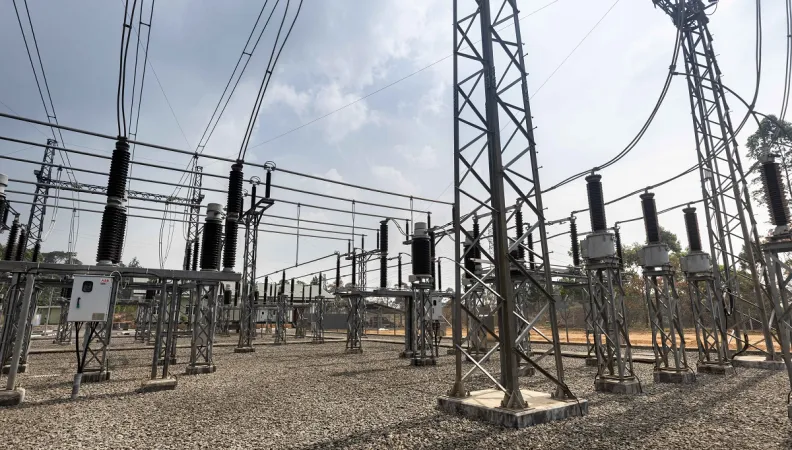Zambia Launches 85MW Industrial Power Integration
Zambia commissions UCF’s 85 MW plant as ZMW=X holds near 22.6 and HG=F trades around $4.10/lb; ≈45 MW grid dispatch plus captive supply cuts outage risk, supporting eurobond spread compression if operational uptime and payments remain disciplined.

Zambia’s commissioning of the 85 MW United Capital Fertiliser (UCF) power plant in Chilanga marks a shift from reactive load management to embedded, investment-led energy resilience. The integrated fertiliser-chemicals complex links on-site thermal generation to heavy industrial processes, dedicating roughly 45 MW to the national grid and about 40 MW to captive operations.
The configuration reduces outage risk for critical inputs such as acid and urea while adding firm capacity to a system in which hydropower still accounts for roughly 84% of installed supply and drought cycles have repeatedly constrained output. The commissioning lands as mining remains the dominant export engine and the principal transmission channel from power reliability to external balances and fiscal revenue.
The mechanism compresses the “power risk premium” embedded in industrial working capital. Captive generation stabilises heat and power loads for energy-intensive processes, reducing production variance and lowering dependence on diesel back-up and emergency imports. Surplus dispatch into the grid provides peaking support during low-hydro periods, improving system frequency and reducing the incidence of rotational cuts.
The embedded model also narrows foreign-exchange exposure by substituting domestic energy for imported intermediates and by securing fertiliser feedstocks at stable cost, lifting predictability in agriculture and mining supply chains.
Macro transmission is direct. Copper volumes and smelter utilisation have historically been curtailed by power rationing, with output losses feeding quickly into export receipts, the current account, and tax collection. At prevailing prices around HG=F ≈ $4.10/lb, a 5% swing in annual copper output equates to several hundred million dollars in export value.
By stabilising industrial consumption and supplying approximately 45 MW to the grid, the UCF plant reduces outage-related variance, moderates logistics and generator fuel costs, and softens second-round effects on consumer prices. Inflation, still elevated in low double digits, benefits from lower energy pass-through as grid reliability improves.
The financing structure aligns with post-restructuring fiscal strategy. With public debt near 68% of GDP, Zambia is leaning on privately financed, grid-integrated assets that limit new sovereign exposure and shift execution risk to operators governed by performance and payment discipline. Replacing emergency power imports with contracted private dispatch narrows quasi-fiscal losses and strengthens predictability in the utility cash cycle.
Eurobond pricing reflects cautious improvement: the Zambia 2031 sovereign issue traded around a 17.7% yield in mid-October, lower than early-year stress levels, consistent with incremental confidence in fiscal execution and a more diversified energy path. Separately, domestic-currency yields remain high and should be discussed distinctly from external debt to avoid curve-mixing errors.
Regional dynamics reinforce the logic. As Zambia augments hydro with thermal and utility-scale solar, it reduces rainfall beta while positioning to sell firm power into the Southern African Power Pool. The 100 MW Chisamba solar facility supporting First Quantum Minerals adds daylight generation that complements thermal reliability and hydropower storage management. For cross-border investors and offtakers in the Democratic Republic of Congo, where power deficits constrain metals output, predictable Zambian dispatch improves procurement planning and lowers the need for high-cost self-generation.
Market interpretation focuses on execution and scalability. The Kwacha (ZMW=X) trades around 22.6 per USD, sensitive to copper prices and seasonal FX flows but supported at the margin by lower outage risk and a more predictable import bill. Equity exposure remains concentrated, yet earnings visibility could broaden if embedded generation demonstrably halves industrial load-shedding and stabilises operating leverage in manufacturing and agro-processing. Bank credit conditions, historically tight for capex in power-exposed sectors, should ease as lenders recalibrate collateral haircuts and cash-flow volatility assumptions.
The economic signal is structural and measurable. Over the next 12–18 months, confirmation requires three indicators: first, sustained grid dispatch near 45 MW from UCF with availability above 80%, demonstrating operational reliability; second, mining output losses attributable to power constraints falling below 2% annually, validating supply-chain resilience; third, the 2031 eurobond yield tightening by at least 50 basis points from mid-October levels if fiscal and energy metrics hold, reflecting lower sovereign risk premia.
If these conditions are met alongside ZMW=X stability within its current band and HG=F near recent averages, Zambia will have reduced its rainfall dependency, improved its fiscal baseline via lower quasi-fiscal losses, and established a replicable template for grid-integrated, privately financed industrial power. Failure to sustain dispatch, enforce payment discipline, or standardise tariffs would prolong high risk premia, crowd out private investment, and keep growth hostage to hydrology.





